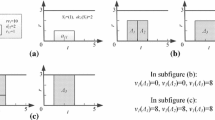Abstract
This paper addresses the problem of resource allocation in a finite-capacity, stochastic (random) and dynamic multi-project system. The system is modeled as a queuing network that is controlled by limiting the number of concurrent projects. We propose a Cross Entropy (CE) based approach to determine near-optimal resource allocations to the entities that execute the projects. The performance of the suggested approach is demonstrated through numerical experiments and compared to that of a heuristic, rough-cut based method.
Similar content being viewed by others
Explore related subjects
Discover the latest articles, news and stories from top researchers in related subjects.References
Adler, P. S., Mandelbaum, A., Nguyen, V., & Schwerer, E. (1995). From project to process management: an empirically-based framework for analyzing product development time. Management Science, 41(3), 458–484.
Anavi-Isakow, S., & Golany, B. (2003). Managing multi-project environments through constant work-in-process. International Journal of Project Management, 21(1), 9–18.
Cohen, I., Mandelbaum, A., & Shtub, A. (2004). Multi-project scheduling and control: A process-based comparative study of the critical chain methodology and some alternatives. Project Management Journal, 35(2), 39–50.
Cohen, I., Golany, B., & Shtub, A. (2005). Managing stochastic, finite-capacity, multi-project systems through the Cross Entropy methodology. Annals of Operations Research, 134, 183–199.
Gemmill, D. D., & Edwards, M. L. (1999). Improving resource-constrained project schedules with look-ahead techniques. Project Management Journal, 30(3), 44–55.
Griffin, A. (2002). Product development cycle time for business-to-business products. Industrial Marketing Management, 31, 291–304.
Hopp, W. J., & Spearman, M. L. (1996). Factory physics—foundations of manufacturing management. Boston: Irwin.
Kapur, J. N., & Kesavan, H. K. (1992). Entropy optimization principles with applications. New York: Academic.
Kropp, D. H., & Carlson, R. C. (1984). A lot-sizing algorithm for reducing nervousness in MRP systems. Management Science, 30, 240–244.
Kurtulus, I., & Davis, E. W. (1982). Multi-project scheduling: Categorization of heuristic rules performance. Management Science, 28(2), 161–172.
Law, A. M., & Kelton, W. D. (1991). Simulation modeling and analysis. New York: McGraw–Hill.
Lee, B., & Miler, J. (2004). Multi-project management in software engineering using simulation modeling. Software Quality Journal, 12(1), 59–82.
Levy, N., & Globerson, S. (1997). Improving multiproject management by using a queuing theory approach. Project Management Journal, 28(4), 40–46.
Leung, H. K. N. (2002). Estimating maintenance effort by analogy. Empirical Software Engineering, 7, 157–175.
Martien, H. A., Hendricks, B. V. & Leon, H. K. (2002). Human resource allocation in a multiproject research and development environment. In: J. S. Pennypacker, L. D. Dye (Eds.), Managing multiple projects (pp. 249–262). New York: Marcel Dekker.
Rubinstein, R. Y. (1997). Optimization of computer simulation models with rare events. European Journal of Operations Research, 99, 89–112.
Rubinstein, R. Y., & Kroese, D. P. (2004). The cross entropy method: A unified approach to Monte Carlo simulation, randomized optimization and machine learning. Berlin: Springer.
Rubinstein, R., & Melamed, B. (1998). Modern simulation and modeling. Berlin: Wiley.
Speranza, M. G., & Vercellis, C. (1993). Hierarchical models for multi-project planning and scheduling. European Journal of Operational Research, 64, 312–325.
Author information
Authors and Affiliations
Corresponding author
Rights and permissions
About this article
Cite this article
Cohen, I., Golany, B. & Shtub, A. Resource allocation in stochastic, finite-capacity, multi-project systems through the cross entropy methodology. J Sched 10, 181–193 (2007). https://doi.org/10.1007/s10951-007-0013-0
Published:
Issue Date:
DOI: https://doi.org/10.1007/s10951-007-0013-0




